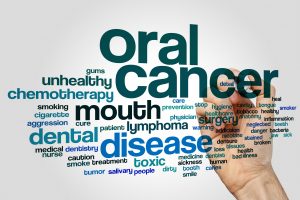
Did you know that over 36,000 men and women in the U.S. are diagnosed annually with oral cancer? According to the National Institutes of Health, not only are tens of thousands of Americans newly-diagnosed with the deadly disease each year, but oral cancer also claims the lives of roughly 8,000 people during that same time period. Early detection is critical to surviving oral cancer – and a dentist in Dublin can help. April is Oral Cancer Awareness Month, so there is no better time than now to learn about the warning signs of the disease and why visiting a dentist regularly is so important.
What is Oral Cancer?
Cancer occurs when there is an uncontrolled division of abnormal cells in the body. Cancer that develops in parts of the throat and mouth – including the lips, tongue, gums, soft tissue inside the mouth, tonsils, esophagus and middle region of the throat – is commonly known as oral cancer.
According to the National Institutes of Health, oral cancers are the sixth most common cancers in the world. Be on the alert for the warning signs of cancer, such as:
- Red or white dots or patches in the mouth
- Lumps, bumps or thickened areas of skin inside the mouth or throat
- Unexplained pain or numbness in the tongue or mouth
- The feeling that something is stuck in the throat
- Difficulty chewing or swallowing
- Ear pain without any loss of hearing
How Can a Dentist Help?
An oral cancer screening is included as part of every routine dental checkup. During your next screening, your dentist will:
- Visually inspect inside your mouth for signs of oral cancer
- Manually examine your neck, face and head for unusual bumps and masses
- Ask questions about exposure to oral cancer risk factors (e.g., tobacco use)
- Ask questions to help identify nonvisible symptoms of oral cancer (e.g., hoarse voice)
How Technology Can Aid Early Detection
Some dental practices have embraced the latest technology, such as an Oral ID, to help detect oral cancer in its earliest stages.
A small handheld device that appears similar to a flashlight, the Oral ID uses a specific light wavelength to visually differentiate healthy and unhealthy tissues in the mouth. When used during an oral cancer screening, the Oral ID light reflects green color off of healthy tissue, while abnormal tissue (such as pre-cancerous cells) appears dark.
This technology is yet another valuable tool to catch oral cancer before it can develop and spread.
How Often Should I See a Dentist?
The American Dental Association recommends visiting a dentist every six months for a routine dental exam and cleaning. Biannual dental checkups, including an oral cancer screening, help ensure that oral cancer and other serious oral health problems are detected early on.
Preventive dental care is critical to maintaining a healthy smile for many years to come. Do not hesitate to contact a dentist in Dublin to learn more during Oral Cancer Awareness Month.
About the Author
A proud graduate of The Ohio State University College of Dentistry and an avid Buckeye fan, Dr. Eric Buck is passionate about helping his patients achieve and maintain excellent oral health. For this reason, offers to use the Oral ID screening device during dental checkups. For more information on oral cancer screenings, visit the Distinctive Smiles of Dublin website or call Dr. Buck at 614-792-1800.
